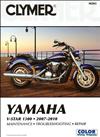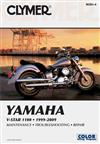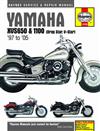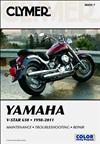Yamaha V-Star Motorcycle workshop manual
The Yamaha DragStar 950 is a cruiser motorcycle made by Yamaha engine providers.
The DragStar 950 has received typically positive reviews and was awarded V Twin mag's "Metric of the Year" award for 2009.
The V-Max is created by Atsushi Ichijo in
Yamaha V-Star 1300 XVS13A and XVS13CT 2007 - 2010Clymer Owners Service and Repair Manual

Softcover - 372 pages - Yamaha V-Star 1300 XVS13A XVS13CT 2007 - 2010 Clymer Owners Service Repair Manual covers the following models: V-Star 1300 XVS13A (2007-2010) V-Star 1300 XVS13CT (2007-2010)Contents: QUICK REFERENCE DATA GENERAL INFORMATIONManual organization / Warnings cautions and notes / Safety / Serial numbers / Fasteners / Shop supplies / Tools / Measuring tools / Electrical system fundamentals / Service methods / Storage / Specifications TROUBLESHOOTINGEngine starting / Engine will not start / Engine performance / Engine noises / Engine lubrication / Cylinder leakdown test / Clutch / Transmission and shift mechanism / Fuel system / Fuel pump troubleshooting / Electrical testing / Electrical troubleshooting / Cooling system troubleshooting / Front suspension and steering / Brake MAINTENANCE LUBRICATION and TUNE-UPMaintenance schedule / Cylinder numbering and engine rotation / Tune-up / Air filter / Engine compression test / Ignition timing inspection / Valve clearance / Spark plugs / Engine oil / Clutch cable free play / Shift pedal height / Fuel and exhaust systems / Throttle valve synchroniz
Yamaha V-Star 1100, XVS1100, XVS1100 Custom and XVS1100A Classic 1999 - 2009 Clymer Owners ...

Softcover - 406 pages - Yamaha V-Star 1100 XVS1100 XVS1100 Custom XVS1100A Classic 1999 - 2009 Clymer Owners Service Repair Manual covers the following models: Yamaha XVS1100 1999 Yamaha XVS1100 Custom 2000-2009 Yamaha XVS1100A Classic 2000-2009Contents: QUICK REFERENCE DATA GENERAL INFORMATIONManual organization / Model names and numbers / Warnings cautions and notes / Safety / Serial numbers / Fasteners / Shop supplies / Tools / Precision measuring tools / Electrical system fundamentals / Basic service methods / Storage / Serial numbers / Model names and numbers / Decimal and metric equivalents / Specifications / Conversion formulas Technical abbreviations TROUBLESHOOTINGOperating requirements / Starting the engine / Starting difficulties / Engine performance / Engine noises / Engine lubrication / Engine leakdown test / Clutch / Gearshift linkage / Transmission / Final drive / Carburetor / Carburetor heater / Fuel pump / Electrical testing / Electrical test equipment / Bas
Yamaha XVS650 and 1100 Drag Star / V-Star 1997 - 2005Haynes Owners Service and Repair Manual

Hardcover - 302 pages - Yamaha XVS650 1100 Drag Star / V-Star 1997 - 2005 Haynes Owners Service Repair Manual covers the following Models:Europe XVS Drag Star models: Yamaha XVS650 1997-2005 Yamaha XVS650A Classic 1998-2005 Yamaha XVS1100 1999-2005 Yamaha XVS1100A Classic 2000-2005U.S. XVS V-Star models: Yamaha XVS650 Custom 1998-2005 Yamaha XVS650A Classic 1998-2005 Yamaha XVS650S Silverado 2003-2005 Yamaha XVS1100 Custom 1999-2005 Yamaha XVS1100A Classic 2000-2005 Yamaha XVS1100S Silverado 2002-2005Contents: YAMAHA XVS V-TWIN Maintenance- Routine Maintenance And Servicing- Specifications- Recommended Lubricants And Fluids- Maintenance Schedule- Component Locations- Maintenance Procedures Yamaha Xvs V-Twin Repairs
Yamaha V-Star 650 1998 - 2011 Clymer Owners Service and Repair ManualModels: Custom, Classic ...

Softcover - 376 pages - Yamaha V-Star 650 1998 - 2011 Clymer Owners Service Repair Manual covers the following models: V-Star 650 Custom 1998 - 2011 V-Star 650 Classic 1998 - 2011 V-Star 650 Silverado 1998 - 2011Contents: Quick Reference Data General InformationManual Organization / Notes Cautions And Warnings / Safety First / Service Hints / Washing The Bike / Special Tips / Torque Specifications / Fasteners / Lubricants / Rtv Gasket Sealant / Gasket Remover / Threadlocking Compound / Expendable Supplies / Serial Numbers / Warning And Information Labels / Basic Hand Tools / Precision Measuring Tools / Special Tools / Fabricating Tools / Mechanics Tips / Ball Bearing Replacement / Seals / Riding Safety / Storage / Specifications TroubleshootingOperating Requirements / Troubleshooting Instruments / Starting The Engine / Starting Difficulties / Engine Starting Troubleshooting / Engine Performance / Engine Noises / Engine Lubrication / Cylinder Leakdown Test / Clutch / Gearshift Linkage / Transmission / Electrical Troubleshooting Test Equipment / Basic Test
The DragStar 950 has received typically positive reviews and was awarded V Twin mag's "Metric of the Year" award for 2009.
The V-Max is created by Atsushi Ichijo in a team led by Akira Araki with input from Ed Burke and John Reed.
Upon its release in 1985, the V-Max garnered immediate important recognition and acquired the name "cycle of the Year" from period Guide. Sold both in Japan and abroad, the V-Max ended up being offered with best lesser modifications through the 1985 design year before the 2007 design seasons. The V-Max had been noted for the fast speed, but was also criticized for the poor cornering capability and smooth suspension.
Until 2008, the initial V-Max is supplied on the market through the Star motorbikes unit of Yamaha Motorcycles. Aside from a freshening into bicycle's specifications in 1993, when the bicycle attained a larger-diameter fork to reduce high-speed wobbling and drift, four-piston brake calipers, along with other handling and protection related updates, the 2007 V-Max had been practically the same as the original 1985 version.
Yamaha VMAX 1998 dash
Standards
In general, the V-Max had been 2,300 mm lengthy, 795 mm wide, and 1,160 mm highest. The engine ended up being a tuned version of the two fold overhead camshaft, four valve per cylinder, liquid-cooled V-4 from Yamaha Venture. As well as other alterations to your motor, the compression proportion grew up to 10.5:1, and the V-Boost program was included.
V-Boost
V-Boost was something that opens butterfly valves into the intake manifold between the 1st and 2nd and involving the third and 4th cylinders beginning with 5,750 rpm. The valves is exposed slowly to match the rising engine speed with an indication provided by the ignition program. The valves have reached the full open position at 8,000 rpm. A little black colored package sends a computed signal to a servo motor that draws a wire to open the butterfly valves. The V-Boost program adds 10 percent toward top energy score for the base engine.
In 2005, within 39th Tokyo Motor program, Yamaha shown an all-new V-Max concept cycle. It showcased a new framework, upgraded elements all over, and state-of-the-art braking elements.
On 4 Summer 2008, Yamaha officially circulated a completely redesigned 2009 VMAX in the united states and European countries. The options that come with the VMAX consist of an all-aluminium frame with its 1,679 cc liquid-cooled 65° V4 DOHC motor made use of as an anxious member of the chassis, an electroluminescent tool readout, Yamaha Chip Controlled Intake, completely flexible suspension, anti-lock brake system, slipper clutch, a fuel container underneath the seat, and a distinctive secret.
On 20 September 2009, VMAX has also been launched in India.
YCC-I/YCC-T
As opposed to the V-Boost regarding initial carburated V-Max, the gas injected VMAX uses YCC-I and YCC-T. Yamaha processor chip Controlled Intake was a unique connection to your VMAX. The airhorns inside the airbox tend to be lifted by a servo activated at 6,650 rpm to open within the airway underneath. This shortens the size of the intake system from 150 mm to 52 mm. This system have their first look in Yamaha stable aided by the 2006 YZF-R1. The MV Agusta F4 Tamburini is the very first bike with these types of something. Massimo Tamburini created this idea. It really is called Torque Shift System in the Agustas.
Yamaha processor chip Controlled Throttle normally a fresh extension. The throttle cables is connected to a throttle place sensor and a computer labeled as G.E.N.I.C.H. that operates the butterfly valves, the EXUP valve inside exhaust additionally the more equipment engaging, such as the igniter unit, while the YCC-I lifter device. The YCC-T computes all of the input of sensors and determines top throttle position, ignition advance, EXUP device and injection amount of time in milliseconds.
The Yamaha XV1900A cruiser was developed to make use of the large displacement end of this marketplace for big cruisers. Yamaha have a well established range of big "Star" cruisers which gone as much as the Wild Star 1600 cc but there was a necessity to redesign the system to fulfill anticipated exhaust emissions laws and also the possibility to update the styling, which have stayed largely unchanged for a decade.
The 1,854 cc four-stroke air-cooled V-twin motor ended up being purpose-built to produce maximum torque at 2,500 rpm when you look at the 55 to 75 miles per hour number employed for motorcycle cruising. Put at 48 degrees, the cylinders has a four pushrod valves, twin spark plug cylinder heads, with forged pistons having an Alumite coating to lessen rubbing and ceramic-composite-coated cylinders.
With an undersquare bore and swing of 100mm x 118mm, the engine possess a compression ratio of 9.5:1 and it is the initial Yamaha cruiser motorcycle to be loaded with the small fatigue perfect Power device four-stroke power device program previously only available on their particular line of high performance activities motorcycles.
An unusual feature associated with brand-new system try an unique 'Pent-roof burning chamber', built to boost the effectiveness of fuel circulation. The system even offers counter-rotating balancers on both stops associated with the crankshaft to cut back the vibration typical of huge V-Twins.
Transmission
The engine’s production was transmitted via a wide-ratio five-speed gearbox and compact new transfer circumstances, with energy shipping controlled by a hydraulic clutch featuring a four-step flexible lever. For quiet procedure as well as low maintenance criteria, the Midnight celebrity has a belt drive system.
Frame
A lightweight longer wheelbase frame ended up being created using aluminum die casting to minimize weight, with a two fold cradle design to supply the energy. Suspension system consists of a die cast aluminum swinging supply and a hidden single horizontal back surprise absorber and large diameter front side forks.
Raider variation
Beginning in 2008, a customized variation was stated in restricted data featuring a lower life expectancy chair, lengthened forward forks, a broader 210 mm back tyre, the widest on any Yamaha motorcycle, and unique black colored finish toward system and a selection of personalized accessories.
The Yamaha DragStar 650 is a bike from Yamaha Motor business.
In line with the Yamaha Virago 535 motor, the XVS650 cylinders had been bored stiff one more 5 mm to 81 mm and stroked 4 mm even more to 63 mm, to net a displacement of 649 cc. The XVS650 is available in two versions: the Customized with less seat level 695 mm and slightly less fat, while the Vintage with an increased chair height of 708 mm. The Customized try approximately 232 kg plus the Vintage around 15 kg heavier 247 kg.
The Yamaha XVS650 is sold into the U.S. as entry-level models of the V-Star line. That line is provided from 1998 to 2008 in two different models: the Classic together with Silverado. Both versions are built all over same 649 cc v-twin motor. The V-Star range provides the looks of larger v-twin motorcycles paired with the gasoline efficiency, dependability, and nimble maneuvering of a mid-size cruiser.
V-star
The V-Star 650 bikes are presented in three trims:
V-Star Personalized XVS650 - Base version for long-distance cruising.
V-Star Vintage XVS650A - equivalent framework while the V-star Personalized but with wider front-wheel, metal fenders, much longer bodywork, less chromed styling, dragged handlebars, wide seat and various styling differences.
V-Star Silverado - Much while the V-Star Classic with saddlebags and a few more "touring" additions
Some V-Star motorbikes are available what other people may know as deepish purple with flames. There were 2 editions made of this. The XVS65T-F while the XVS65TC-F. CA edition is for California Only and it is built with a canister to prevent the discharging of fuel vapor into the atmosphere. You will find 3 lines to this canister. Someone to the gasoline container, someone to the carburetor and a vent hose. Both of these models if the VIN are decoded will show up either XVS650 and XVS650A mostly because their particular components are exactly the same as these 2 products with very few exceptions if any.
All of these are the base versions of the RoadStar. The "RoadStar" and "RoyalStar" generally speaking refers to the class of bicycles which are made and fine-tuned for touring performance
2009
There have been no spec changes between 2008 and 2009 models.
V-Star Vintage available from June 2008
V-Star Custom available from June 2008; CA model from August 2008
V-Star Silverado available from June 2008
2008
V-Star Classic offered by September 2007
V-Star Customized offered by September 2007
V-Star Silverado available from March 2008
Origins: 1955
The bike division of Yamaha ended up being launched in 1955, and is lead by Genichi Kawakami. Yamaha's preliminary product ended up being a 125cc two-cycle, single cylinder bike, the YA-1, that was a copy of this German DKW RT125. The YA-1 is an aggressive triumph at racing from the beginning, winning not just the 125cc course within the Mt. Fuji Ascent, additionally sweeping the podium with very first, second and 3rd place in the All Japan Autobike stamina Road competition that exact same 12 months. Early triumph in rushing ready the tone for Yamaha, as competitors in many varieties of motorcycle race has-been a vital undertaking of providers throughout its records, frequently fueled by a strong rivalry with Honda along with other Japanese manufacturers.
Yamaha started competing internationally in 1956 if they joined the Catalina Grand Prix, once more utilizing the YA-1, at which they put sixth. The YA-1 was followed by the YA-2 of 1957, another 125cc two stroke, however with considerably enhanced framework and suspension. The YD-1 of 1957 ended up being a 250cc two-stroke twin cylinder motorcycle, resembling the YA-2, however with a more substantial and much more powerful motor. A performance form of this bike, the YDS-1 housed the 250cc two-stroke twin in a double downtube cradle framework and offered the initial five-speed transmission in a Japanese bike. This era also saw Yamaha promote its first outboard marine system.
Achievements and development in the 1960s
By 1963 Yamaha's dedication to the two-stroke system and rushing paid down due to their first victory in worldwide competitors, at the Belgium GP, in which they obtained the 250cc course. Achievements in product sales ended up being even more impressive, and Yamaha set-up 1st of their intercontinental subsidiaries within stage starting with Thailand in 1964, while the Netherlands in 1968. 1965 saw the release of a 305cc two-stroke twin, the leading regarding the businesses lineup. They featured a different oil offer which straight injected oils into the gas ahead of combustion. In 1967 a unique bigger displacement model ended up being added to the range, the 350cc two-stroke twin R=1.
In 1968 Yamaha established their particular earliest four-stroke motorcycle, the XS-1. The Yamaha XS-1 is a 650cc four-stroke twin, a more substantial and much more powerful device that equaled the displacement and performance associated with the preferred Brit bicycles associated with the era, including the Triumph Bonneville and BSA Gold Star. Yamaha carried on on with the two-stroke range and four-stroke twins at a time that various other Japanese manufacturers had been progressively moving to four-cylinder four-stroke devices, a trend led by Honda in 1969 with all the legendary CB-750 four-stroke four-cylinder period.
The four-stroke era starts: the 1970s
Not until 1976 would Yamaha respond to one other Japanese companies with a multi-cylinder four stroke of one's own. The XS-750 a 750cc triple-cylinder device with shaft best drive had been introduced virtually seven many years after Honda's breakthrough bicycle. Yamaha's earliest four-cylinder model, the XS-1100 then followed in 1978, once again with shaft drive. Despite becoming heavier plus touring focused than its rivals it produced an impressive string of victories in endurance racing.
The 1970s additionally saw a number of the very first specialized off-road bicycles for off road rushing and entertainment. Yamaha was an early innovator in dirt-bike technologies, and introduced the very first single-shock rear suspension system, the trademarked "Monoshock" of 1973. They starred in production in the 1974 Yamaha YZ-250, a model which has proceeded in manufacturing, with several changes, until 2015, which makes it Yamaha's longest continuous design and name.
Yamaha continuing racing through the entire 1960s and 1970s with increasing achievements in many formats. The decade of 1970s ended up being capped by the XT500 winning 1st Paris-Dakar Rally in 1979.
The 1980s: Diversification and Innovation
By 1980 the blend of consumer preference and environmental legislation made four shots increasingly popular. Suzuki ended production of their particular GT two stroke series, including the flagship water-cooled two-stroke 750cc GT-750 in 1977. Kawasaki, who'd significant success through the 1970s with their two-stroke triples of 250cc, 350cc, 500cc and 750cc concluded production of road-going two shots in 1980. Yamaha bucked this trend and proceeded to improve and offer two-strokes for the street in to the 1980s. These bicycles were performance focused, water-cooled twin-cylinder devices, built to achieve excellent efficiency using the low weight of two strokes. The RZ-250 of 1980 ended up being the progenitor for this series. The RZ-350, the biggest displacement model, is a well known hot-rod bike associated with the 1980s and always been marketed in some nations into the very early 1990s.
Through the entire 1980s the bike business slowly went from building a few standard but flexible versions made to work nicely in lots of functions, to supplying additional specialized devices designed to succeed particularly markets. These included rushing and performance road riding, touring, motocross racing, enduro and leisure off road riding, and cruising. Yamaha branched out from the fairly small number of UJMs in the very beginning of the decade to a much bigger collection of offerings in lot of clearly defined markets after the decade.
The XV750 of 1981 showcased an air-cooled V-twin four stroke system and cruiser styling, and ended up being one of the primary Japanese cruiser style motorbikes. By the end of this 1980s Yamaha have supplied a large number of cruiser styled bicycles in a number of displacements and motor configurations.
The RZV500 is among the first "repli-racers", an almost copy of Kenny Roberts competition GP cycle, it showcased a liquid-cooled two-stroke engine of 500cc displacement in a V4 configuration, alongside a perimeter framework and full fairing.
A far more popular and useful superior model for the road ended up being introduced in 1985, the FZ750. It absolutely was a forward thinking 750cc four-stroke inline four-cylinder design. It absolutely was the first motorcycle to showcase a five valve cylinder mind, some thing Yamaha became well known for. In addition showcased a cylinder block canted forward at 45 degrees, and a box-section steel border framework. Production of the FZ continuing until 1991.
The 1990s: Performance bikes and a spin-off brand name
In 1998 Yamaha advertised a 1000cc four cylinder road-bike known as the YZF 'R1', this model introduced a design of gearbox build which reduced the overall period of the motor/gearbox situation, to allow a more lightweight device. This, in turn allowed the motor becoming placed in the framework further forth, made to improve handling in a short wheel-based frame.
In 1995, Yamaha announced the development of Star Motorcycles, a new brand because of its cruiser group of motorbikes within the US markets. Various other areas, Star motorbikes are marketed beneath the Yamaha brand name. It was an attempt generate a brand identity most closely aligned with all the cruiser market part, among largest and a lot of lucrative in america.
The 2000s: growth and consolidation
In 2007, Yamaha set up the Philippine operations and distributes Yamaha motorbikes underneath the corporate title of Yamaha engine Philippines, Inc., certainly one of a lot more than 20 global subsidiaries running on all continents.